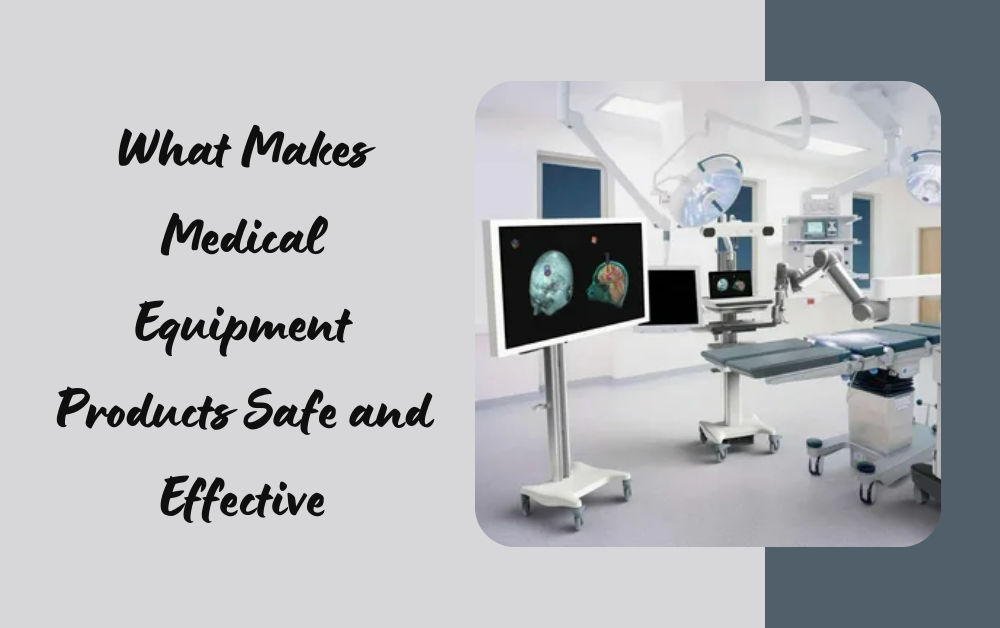Medical equipment plays a crucial role in healthcare, ensuring accurate diagnosis, treatment, and patient care. Understanding what makes these products safe and effective is paramount for healthcare providers and patients alike. This blog explores the key factors contributing to the safety and efficacy of medical equipment, highlighting the importance of quality standards and regulatory compliance.
Introduction
In today’s healthcare landscape, the demand for reliable and high-quality medical equipment is non-negotiable. From diagnostic tools to therapeutic devices, every piece of equipment must meet stringent standards to ensure patient safety and optimal treatment outcomes. This blog delves into the essential elements that define the safety and effectiveness of medical equipment, guiding healthcare professionals and consumers through critical considerations.
Note:- Discover how our range of Medical Equipment Products can enhance safety and efficiency in your healthcare practice. Explore our comprehensive catalog today to find innovative solutions designed to elevate patient care standards.
Importance of Regulatory Standards
Regulatory Compliance Ensures Safety
Medical equipment must adhere to rigorous regulatory standards set by authorities such as the FDA (Food and Drug Administration) in the United States or the CE (Conformité Européenne) marking in Europe. These standards ensure that devices undergo thorough testing for safety, performance, and reliability before they reach healthcare settings. Compliance with regulations not only safeguards patients but also instills confidence in healthcare providers regarding the equipment’s efficacy.
Quality Assurance Processes
Behind every safe medical device lies a robust quality assurance process. Manufacturers employ stringent quality control measures throughout the production cycle, from design and development to manufacturing and distribution. Quality assurance protocols involve testing for durability, accuracy, and functionality to mitigate risks and uphold product excellence. These processes are integral to maintaining consistent standards and mitigating potential defects that could compromise patient safety.
Design and Engineering Principles
Design for Safety and Usability
The design phase of medical equipment is critical in determining its safety and usability. Engineers focus on ergonomic principles and user-centered design to optimize functionality while minimizing risks of user error. Factors such as intuitive interfaces, clear labeling, and ergonomic features contribute to equipment that is easier to operate and less prone to misuse or accidents. Design considerations also extend to materials used, ensuring they are hypoallergenic, durable, and compatible with medical environments.
Innovation and Technological Advancements

Advancements in technology continually shape the landscape of medical equipment. From AI-driven diagnostics to wireless monitoring systems, innovative technologies enhance the safety and efficacy of medical devices. These innovations often improve accuracy, reduce procedural risks, and enhance patient comfort, setting new benchmarks for healthcare delivery. However, alongside innovation, rigorous testing and validation are essential to confirm the reliability and safety of new technologies before clinical adoption.
Clinical Validation and Evidence-Based Practice
Evidence-Based Validation
Before medical equipment is integrated into clinical practice, it undergoes extensive validation through clinical trials and studies. Evidence-based validation ensures that devices perform as intended in real-world scenarios, yielding reliable outcomes for patients. Clinical trials assess factors such as accuracy, sensitivity, specificity, and adverse event profiles to establish the safety and efficacy of medical equipment across diverse patient populations.
Continuous Monitoring and Feedback
Even after regulatory approval and clinical validation, the safety of medical equipment relies on ongoing monitoring and feedback mechanisms. Healthcare providers play a crucial role in reporting device malfunctions, adverse events, or usability issues to manufacturers and regulatory bodies. This feedback loop informs product improvements, recalls, and updates, reinforcing the commitment to patient safety and continuous quality improvement.
Patient-Centered Care and Safety
Impact on Patient Outcomes
Safe and effective medical equipment directly influences patient outcomes and quality of care. Accurate diagnostics expedite treatment decisions, while reliable therapeutic devices enhance treatment efficacy and patient comfort. Patient-centered care emphasizes the importance of selecting equipment that prioritizes safety, usability, and positive clinical outcomes, thereby enhancing overall healthcare delivery and patient satisfaction.
Education and Training
Healthcare professionals undergo rigorous training on the safe use of medical equipment to mitigate risks and optimize performance. Training programs cover device operation, maintenance protocols, troubleshooting, and emergency procedures, ensuring that healthcare teams are proficient in handling equipment across various clinical settings. Ongoing education and competency assessments uphold standards of care and promote safe practices in medical device utilization.
Conclusion
In conclusion, the safety and effectiveness of medical equipment are fundamental pillars of modern healthcare delivery. Regulatory compliance, robust quality assurance processes, innovative design principles, evidence-based validation, and patient-centered care collectively contribute to ensuring that medical devices meet the highest standards of safety and efficacy. By prioritizing these factors, healthcare providers can confidently integrate medical equipment into clinical practice, ultimately enhancing patient outcomes and advancing healthcare quality.
This blog has explored the multifaceted aspects of what makes medical equipment products safe and effective, offering insights into the critical considerations that underpin their role in modern healthcare. As technology evolves and healthcare landscapes shift, the commitment to maintaining these standards remains paramount for all stakeholders involved in patient care.
Read more informative blog at findtec.






